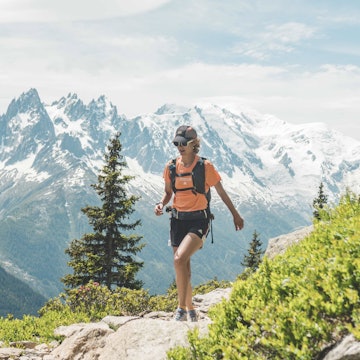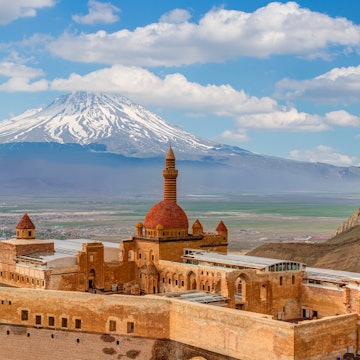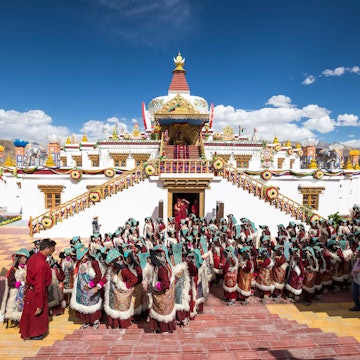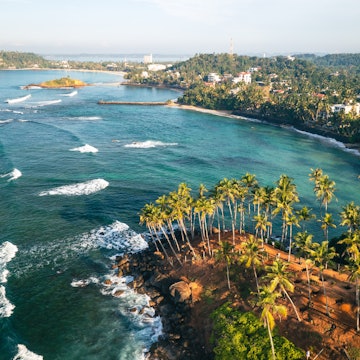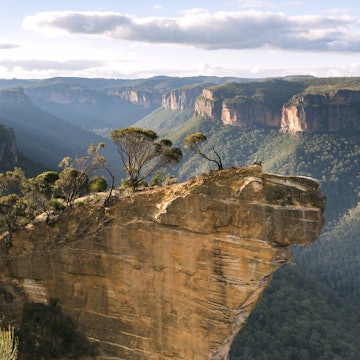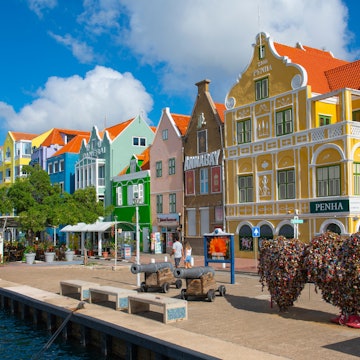

The Santuario de Chimayo is one of the most well-known highlights of the High Road to Taos © S. Greg Panosian / Getty Images
On the basis of worthwhile stops per mile, the High Road – 70 miles winding between Santa Fe and Taos, New Mexico – might be the best short road trip in the United States.
It has dramatic and varied geography, from low deserts and sun-baked pastures to piney mountain passes, wide sandstone cliffs, and river valleys dotted with tin-roofed shacks. It has traditional crafts shops, modern galleries, old churches, and hole-in-the-wall cafés. Above all, the High Road has a palpable sense of history and tradition, with Native American pueblos and Spanish villages existing, in effect, side by side.

Chimayó
Chimayó, the first of many tiny Spanish villages in the Sangre de Cristo Mountains, is a grade-A High Road highlight. The 200-year-old Santuario de Chimayó is the most famous stop on the High Road and the most important pilgrimage site in the United States. In the pocito, a room off the altar, there’s a small, round pit filled with tierra bendita, or holy dirt, which is said to possess healing properties. The faithful come to rub the dirt on themselves; travelers go to the gift shop to buy a vial of it. In the prayer room, discarded canes, braces, and wheelchairs seem to prove the miracle of the Santuario. Be mindful that photography is prohibited inside.
There aren’t many restaurants along the High Road, and certainly none as acclaimed as Rancho de Chimayó. The family-owned restaurant has been serving traditional New Mexican fare in an adobe home near the Santuario for more than 50 years. Signature dishes include carne adovada, a tender pork stew, and sopaipilla relleno, a puffed-up pastry stuffed with meat, rice, and beans. You can’t leave without trying Chimayó’s famous red chile sauce.
After eating, check out two prime examples of Chimayó’s centuries-old crafting tradition. Ortega’s Weaving, a ninth-generation weaving shop and gallery, is just before the SR-76 junction. On the way out of Chimayó, there’s the hacienda-style Oviedo Gallery, run by an eighth-generation descendant of a Spanish woodcarving family. Most of Oviedo’s traditional woodcarvings and contemporary bronze sculptures cost less than $100.
Related content: ‘Red or green?’ New Mexico’s most mouth-watering dishes
Córdova
Córdova’s claim to fame is a rare style of woodcarving pioneered by José Dolores López in the early 20th century: unpainted, intricately carved, and following the wood’s natural grain and knots to form unusual shapes. You can buy santos (saints) at the studio of José’s granddaughter, Sabinita – look for the simple white sign for ‘Sabinita López Ortiz Woodcarving Shop’ just off CR-80.
After about four miles on NM-76, you’ll come across Los Llanitos Cemetery, whose colorful flowers and ornate decorations give it an almost celebratory vibe. Two royal-blue wrought-iron motorcycles guard a special marked-off grave.

Truchas
Robert Redford chose to film The Milagro Beanfield War here, and you can see why. The drive into Truchas offers spectacular views of the Rio Grande basin and the snow-capped Truchas Peaks off to the east, and the village itself feels like a place that time has passed by, with run-down buildings pressed up against narrow streets.
In recent years, artists have been drawn by Truchas’s remote, quintessentially New Mexican beauty. Numerous galleries are clustered along CR-75, including Hand Artes Gallery (folk art), Judith Hert (abstract paintings), and Sally Delap-John (watercolors). A good one-stop shop is High Road Art Gallery, which has an eclectic mix of handmade, locally produced artworks priced lower than comparable items in Santa Fe or Taos.

Trampas
The village of Trampas was established in 1751 and is now a National Historic District. Its small plaza is anchored by the Church of San José de Gracia, a well-preserved Spanish colonial-style church completed in 1776. A small stand on the plaza sells souvenirs and fresh fruit. The church is open to visitors on weekends.
Peñasco
Driving into Peñasco, you can’t miss the green building covered in vivid murals. You wouldn’t want to, anyway. It’s home to the cozy Sugar Nymphs Bistro, which serves ‘city cuisine’ – think goat cheese salad, vegetarian egg scramble, and triple-layer chocolate cake, all with locally sourced ingredients – in a ‘country atmosphere.’
The final third of the High Road winds through high elevations of Carson National Forest. Nine miles from Peñasco, on the east side of SR-518, is a scenic overlook. Sit on the single weathered bench to admire the view and digest your meal before the upcoming switchbacks.

Pot Creek Cultural Site
Seven hundred years ago, Pot Creek Pueblo was home to almost a thousand Anasazi people, in a large adobe compound much like Taos Pueblo. Today, most of the abandoned pueblo lies on private land, but the adjacent Pot Creek Cultural Site is open to visitors from June to September. Walk the one-mile loop trail to see ancient pottery, stone artifacts, and the ruins of three adobe dwellings (plus one that’s been restored, with an eight-room home and Anasazi kiva).
Talpa
Talpa is the last village on the High Road before Taos. There’s not much to see beyond a charmingly tiny church, perhaps 15 feet tall, with a big name: Nuestra Señora de San Juan de los Lagos del Rio Chiquito. The church isn’t open to visitors, but its rounded bell tower and blue-tiled entrance are impressive.

Taos
Only four miles south of Taos is the High Road’s most iconic church, the San Francisco de Asís, completed in 1815. The church’s adobe exterior looks almost alien in its rounded smoothness, but up close, bits of straw poke through the dry, cracked mud and glitter in the sun like flecks of gold. Every June, in a project called the enjarre, or ‘mudding,’ volunteers and parishioners re-plaster the six-foot-thick walls in adobe. Make sure to walk around to the rear of the church – a favorite perspective for Georgia O’Keeffe and Ansel Adams – to see its beehive-like buttresses.







